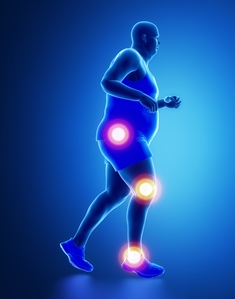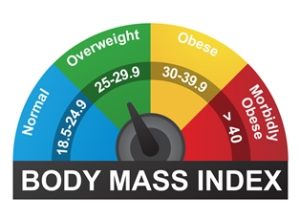How to exercise to lose weight when exercise is painful

High body mass index (BMI) is significant factor in low back pain, osteoarthritis; hip osteoarthritis; knee osteoarthritis, plantar heel pain.

Weight loss intervention for pain reduction
Decreasing body weight is an effective intervention to decrease musculoskeletal pain. Research by Stephen Messier at Wake Forest U, looking at individuals with painful osteoarthritis of the knee who lost 20% of their body weight that had a 25% reduction in pain and improved function. This reduction in pain and improvement in function occurred without drugs or surgical intervention.
Since 2015, the National Institutes of Health has recommended that overweight individuals with knee arthritis can reduce their discomfort by about 50% and improve their function and mobility by losing 10% of their body weight over an 18-month period.
The problem is what if musculoskeletal pain prevents or limits our ability to exercise. How do we exercise to lose weight when exercise is painful?
Some argue exercise may cause further joint damage in obese patients with osteoarthritis because of increased strain and load on the joints. This leads to the hypothesis that weight loss should be achieved prior to commencing exercise. That's why cutting calories through dieting is thought to be more effective for weight loss. But doing both — cutting calories through diet and burning calories through exercise — can help give you the weight-loss edge.
Exercise vs Calories
The key to weight loss is to consume fewer calories than you burn.

There is an ongoing debate as to whether cutting calories or increasing exercise is more important in order to lose weight.
Health researcher Laura Dwyer-Lindgren, at the University of Washington’s Institute for Health Metrics and Evaluation in Seattle, measured activity and obesity in a large population from several states between 2001 and 2011. She concluded that levels of physical activity had shown an increase, but that obesity had also increased.
Seattle researcher, KE Foster-Schubert of the Fred Hutchinson Cancer Research Center (FHCRC), headed a one-year weight-loss study that compared three groups of women – one group that cut calories alone, one that used exercise alone, and a third group that used both exercise and calorie reduction. All groups lost weight. The greatest weight loss was by both cutting calories and exercising. What is of interest is that weight loss can occur by cutting calories without increasing exercise.
Dr. Samuel Klein, a professor of medicine and nutritional science at Washington University in St. Louis, said in a 2013 Forbes magazine article that “decreasing food intake is much more effective than increasing physical activity to achieve weight loss.” If you run 3 miles to burn 300 calories, he said, those 300 calories are replaced by “eating just 2 ounces of potato chips.”
For most people, it's possible to lower their calorie intake to a greater degree than it is to burn more calories through increased exercise. That is why cutting calories is generally more effective to achieve weight loss.
Amy Luke and Richard S. Cooper, researchers at the Stritch School of Medicine at Loyola University in Chicago, headed a study, published in 2013, that produced some eye-opening results. The Luke/Cooper team concluded that exercise plus calorie restriction achieves virtually the same weight-loss results as caloric restrictions alone. Physical activity within the range engaged in by the U.S. population is not modulating the obesity risk, they said. Only reduction in caloric intake will result in weight loss, whether done in isolation or together with increases in exercise.
In short, they said, it doesn’t matter greatly whether you exercise, if you cut down on the calories.
You might expect study results like that to draw some quick and sharp reaction, and they did. A team of University of South Carolina researchers -- Steven N Blair, Edward Archer and Gregory A. Hand – vehemently disagreed with Luke/Cooper. They said the Loyola study ignored “an extensive base of observational and experimental studies that clearly support” an effect of physical activity on obesity.
For most people, it’s possible to lower their calorie intake to a greater degree than it is to burn more calories through increased exercise.
What I conclude from all of this is calorie reduction is important for weight loss, but exercise and increased physical activity in combination with calorie reduction is better. Increased physical activity and exercise provide other benefits in addition to weight loss.
Here, in a nutshell, is the American College of Sports Medicine position on Physical Activity and Weight Loss:
- 150 to 250 minutes/week of moderate-intensity physical activity provides only modest weight loss. More than 250 minutes of moderate-intensity physical activity (35 minutes/day) that uses moderate caloric restriction provides clinically significant weight loss.
- For maintaining weight after weight loss, there is some evidence that greater than 250 minutes/week of moderate-intensity physical activity will prevent weight re-gain.
- Energy/diet restrictions combined with physical activity will increase weight loss more effectively than diet alone.
In combination with a calorie reduction a consultation with a Physical Therapist can assist with designing pain free calorie burning exercise.
Damien Howell Physical Therapy – 804-647-9499 – Fax: 866-879-8591 At-Home, At Office, At Fitness Facility – I come to you, I do home visits Damien@damienhowellpt.com
1 Comments
Leave a Comment
You must be logged in to post a comment.

[…] and increased physical activity in combination with calorie reduction is better,” says Damien Howell, PT, DPT, OCS, of Orthopedic Physical Therapy in Richmond, Virginia. “Increased physical […]